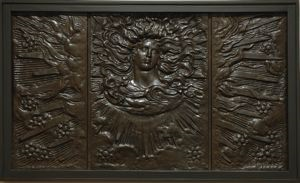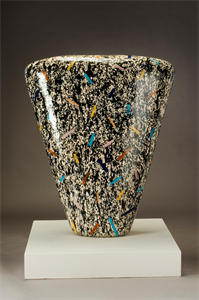Elihu Vedder
| Showing 1 of 1 |
|

Elihu Vedder
American, 1836–1923
The inspiration for "The Soul of the Sunflower" comes from a classical myth featuring the nymph, Clythie, whose story was the source for an explanation of sunflowers. Clythie fell in love with Apollo, the god of the sun. He deserted Clythie, and in despair she went nine days without food or drink, keeping her head turned toward the sun. As a reward for her fidelity, she was changed into a sunflower. The center section features a head shown from the front surrounded by long wavy hair and ray-like forms that radiate from the central aureole into the flanking panels. Multiple sunflower blossoms are scattered around the bottom of the central panel and the outer edges of the flanking panels.
This relief was designed for use as a fireback; its three panels would have lined the interior of a fireplace and protected the brick from heat. Vedder's firebacks were hand-crafted in relatively small numbers and marketed to upper and middle class consumers eager to improve the aesthetics of their domestic environs with decorative arts that embodied period preferences for simple forms and earth-toned imagery inspired by nature. This program was in keeping with decorative arts ideals of the Arts and Crafts Movement espoused by English proponents William Morris and John Ruskin, and Americans Gustaf Stickley and Louis Comfort Tiffany
American, 1836–1923
The Soul of the Sunflower
1881–1882
Object Type:
Sculpture
Creation Place:
North America, American, Massachusetts
Dimensions:
34 in. x 55 5/8 in. x 2 5/8 in. (86.36 cm x 141.29 cm x 6.67 cm)
Medium and Support:
Copper-plated cast iron
Accession Number:
1992.0001 a-c
Credit Line:
Montgomery Museum of Fine Arts Association Purchase
The inspiration for "The Soul of the Sunflower" comes from a classical myth featuring the nymph, Clythie, whose story was the source for an explanation of sunflowers. Clythie fell in love with Apollo, the god of the sun. He deserted Clythie, and in despair she went nine days without food or drink, keeping her head turned toward the sun. As a reward for her fidelity, she was changed into a sunflower. The center section features a head shown from the front surrounded by long wavy hair and ray-like forms that radiate from the central aureole into the flanking panels. Multiple sunflower blossoms are scattered around the bottom of the central panel and the outer edges of the flanking panels.
This relief was designed for use as a fireback; its three panels would have lined the interior of a fireplace and protected the brick from heat. Vedder's firebacks were hand-crafted in relatively small numbers and marketed to upper and middle class consumers eager to improve the aesthetics of their domestic environs with decorative arts that embodied period preferences for simple forms and earth-toned imagery inspired by nature. This program was in keeping with decorative arts ideals of the Arts and Crafts Movement espoused by English proponents William Morris and John Ruskin, and Americans Gustaf Stickley and Louis Comfort Tiffany
Keywords
Click a term to view the records with the same keyword
Portfolio List
Click a portfolio name to view all the objects in that portfolio
This object is a member of the following portfolios:
Your current search criteria is: Related to "Elihu Vedder".
